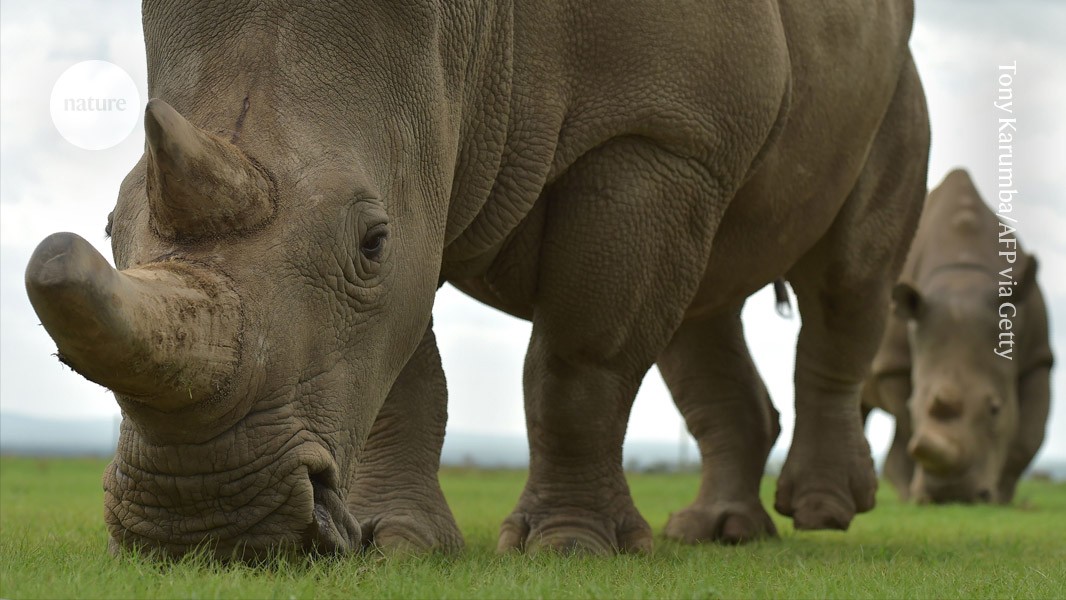Ancient proteins rewrite the rhino family tree — are dinosaurs next?

Molecules from 20-million-year-old teeth are among the oldest ever sequenced

Rhinos’ evolutionary relationships became a little clearer with the sequencing of the oldest proteins yet.Credit: Tony Karumba/AFP via Getty
Researchers have described proteins that they say are among the most ancient ever sequenced. Two teams, which analysed molecules from extinct relatives of rhinos and other large mammals, have pushed back the genetic fossil record to more than 20 million years ago.
The studies — out in Nature today1,2 — suggest that proteins survive better than researchers thought. This raises the possibility of gleaning molecular insights about evolutionary relationships, biological sex and diet from even older animals — maybe even dinosaurs.
“You’re just opening up a whole new set of questions that palaeontologists never thought they could get near,” says Matthew Collins, a palaeoproteomics specialist at the University of Cambridge, UK, and the University of Copenhagen.
Preserved in teeth
The ability to obtain DNA from remains that are thousands of years old has revolutionized biology, revealing previously unknown human groups such as the Denisovans and rewriting the population history of humans and other animals. The oldest sequenced DNA comes from one-million-year-old mammoth bones3 and two-million-year-old Arctic sediments4.
Proteins — biological building blocks encoded by the genome — are hardier than DNA and can push researchers’ abilities to use molecules to understand ancient species deeper into the past. How far is contentious. In 20075 and 20096, researchers described shards of protein from 68-million-year-old and 80-million-year-old dinosaur fossils, respectively, but many scientists doubt the claims.
A 2017 effort7 to redo the 2009 work was more convincing, says Enrico Cappellini, a biochemist at the University of Copenhagen. Yet it obtained only a limited number of sequences — the list of amino acids that describes a protein’s composition — providing only tentative information about evolutionary relationships, he says. He and his colleagues consider the current benchmark for the oldest evolutionarily informative protein ever discovered to be collagen extracted from a 3.5-million-year-old relative of camels from the Canadian arctic8.
To push this limit further, in one of the two latest studies1, Cappellini’s team extracted proteins from the enamel — the mineralized outer layer of teeth — of a 23-million-year-old relative of rhinoceroses. The fossil was found on an island in Canada’s High Arctic region in 1986 and stored in an Ottawa museum. A 2024 preprint attributed it to a new, extinct rhino species called Epiaceratherium itjilik9.
Using mass spectrometry — which detects the weight of a protein fragment, allowing its composition to be inferred — the researchers identified partial sequences from 7 enamel proteins, making up at least 251 amino acids in total.
An evolutionary tree integrating these sequences with genome data from living rhinos and of their two Ice Age relatives revealed a surprise. The Epiaceratherium sample belonged to a branch of the rhino family tree that split off earlier than any other: between 41 million and 25 million years ago. Previous studies placed this group among modern rhinos. “It really does change the way we have to think about the evolution of rhinos,” says Ryan Paterson, a biomolecular palaeontologist at the University of Copenhagen, who co-led the study.
Next step, dinosaurs
Proteins degrade in the heat. The rhino sample that Paterson and his colleagues analysed came from a polar desert where average temperatures are well below freezing, “the perfect place” for protein preservation, he says.
Login or create a free account to read this content
Gain free access to this article, as well as selected content from this journal and more on nature.com
or
Sign in or create an accountdoi: https://doi.org/10.1038/d41586-025-02170-0
This story originally appeared on: Nature - Author:Ewen Callaway


















